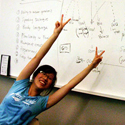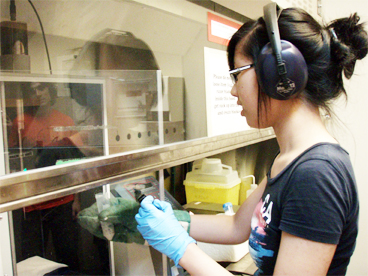Team:British Columbia/Notebook/Week 13
From 2011.igem.org
Watermelon (Talk | contribs) |
Watermelon (Talk | contribs) |
||
| Line 4: | Line 4: | ||
Daisy is beginning expression of the C41 DE3 cells. These cells contain the limonene synthase and other genes from the registry. The C41 DE3 cells also contain another plasmid, from Chris Keeling, called pRARE2. This plasmid codes for rare tRNA codons to help with protein translation. | Daisy is beginning expression of the C41 DE3 cells. These cells contain the limonene synthase and other genes from the registry. The C41 DE3 cells also contain another plasmid, from Chris Keeling, called pRARE2. This plasmid codes for rare tRNA codons to help with protein translation. | ||
| - | [[File:ubcigemwk13daisy.jpg | frame | | + | [[File:ubcigemwk13daisy.jpg | frame | right | Daisy sonicating C41 DE3 cells for in vitro assay of limonene synthase]] |
Revision as of 04:33, 7 September 2011

 |
 |
 |
 |
 |
Characterization: Limonene synthase
Daisy is beginning expression of the C41 DE3 cells. These cells contain the limonene synthase and other genes from the registry. The C41 DE3 cells also contain another plasmid, from Chris Keeling, called pRARE2. This plasmid codes for rare tRNA codons to help with protein translation.
Daisy went to the lab techs to clarify a lot of the steps. Chris Keeling suggested Daisy to follow a protocol in the 2004 Martin paper (http://www.ncbi.nlm.nih.gov/pubmed/15310829). This is because the limonene synthase in the registry is not tagged (not His-tagged specifically) so there is no purification step. Chris Keeling mentioned that they used to do synthase expression without a tag, but it gave messier chromatograms. Now, they use a his-tag for purification purposes. However, the limonene synthase does not have a his-tag so Daisy will be following the previous protocol.
The lab techs (Hannah, Sharon, Harpreet) were extremely nice! In particular, Sharon was very helpful in getting reagents that iGEM did not have, such as geranyl diphosphate (very expensive!!) and pentane (with trace amounts of isobutylbenzene for quantitation) for Daisy (Thanks Sharon!!).
Daisy grew the starter culture of C41 DE3 cells over night. Then she grow the cells in two batches of 500 mL in 2 litre flasks. The cells were then induced with IPTG and grown to absorance = 0.8. Daisy did an overnight expression of the limonene synthase. Daisy then spun down the cells and put them in the -80.
Daisy took 1-2 g of cell pellet with 5 ml of assay buffer. Daisy then sonicated the cells for the in vitro assay. Daisy spun down the cells and took 2 ml of the supernatant for the in vitro assay.
Daisy incubated the 2ml supernatant with geranyl diphosphate (the substrate required for limonene production) and 2 ml of pentane. Daisy did multiple pentane extractions to ensure that all the potential product was collected into the pentane layer. Then, she evaporated the pentane to a volume of 500 ul. Daisy prepared two samples:
- Limonene Synthase (in buffer) + GPP
- Limonene Synthase (in buffer) - GPP
In previous GCMS preparations, done by other lab members, for yeast monoterpene production, there was no internal standard added to the pentane.
For Daisy's second run of limonene synthase, she asked Sharon (from Bohlmann Lab) for some of their pentane with internal standard already added.
This way, if there was production, Daisy can quantify the amount of limonene produced by comparing it to the internal standard.
Daisy and Joe also saw Chris Keeling at lunch today. We had an interesting discussion as Chris Keeling shared his vast knowledge of terpene synthases over a lunch. It was very interesting and helpful to our project! Thanks Chris!
There were also several samples that needed to be run on the SDS PAGE. We tried to use the SDS PAGE equipment that we were given. However, the inner chamber kept leaking and we did not know how to prevent the leaking.
The samples were run in Foster Lab, with Jenny Moon's help. There were several samples to run. The goal was to see a difference in expression between wild type yeast and induced yeast expression. However, there was no difference in bands.
Daisy also ran her limonene pre-induction and post-induction cell lysate on the gels. However, there was no difference. This is probably because of the lac promotor being not as strong as a normal recombinant expression promotor (such as T7).
Dr. Leonard Foster has suggested we try to load more protein in the lanes and then potentially send for mass spec to check for protein expression. Thanks Dr. Foster!
In any case, we will be looking at the GCMS data and if there is product, then it is not necessary to check for protein expression.
 "
"

















